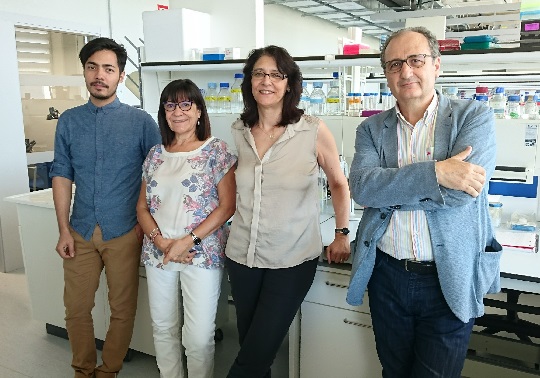Users
Social media
- More details here...
- Address
Parc Científic de la Universitat de València C/
Catedrático Agustín Escardino, 9
46980 Paterna (Valencia) Spain - Email:
iu.i2sysbio@uv.es - Phone:
(+34) 963544810
- Address
Links
They discover that the genome of a bacteria related to bougainvillea is formed by an unprecedented biological fact

Investigation
They discover that the genome of a bacteria related to bougainvillea is formed by an unprecedented biological fact

Research from the Cavanilles Institute of Biodiversity and Evolutionary Biology (ICBiBE-UV) and the Institute of Integrative Systems Biology (Y2SysBio), a joint CSIC-UV center, has described the genome of 'Tremblaya phenacola', a bacteria present in the interior cotonet, parasitic insect of bougainvillea. The unprecedented phenomenon is that this genome is formed by the fusion of the DNA of two phylogenetically very distant types of bacteria.
The research, published in the magazine The ISME Journal, offers new perspectives on research into the evolution of the symbiosis between bacteria and insects.
Rosario Gil, Carlos Vargas, Sergio López, Diego Santos, Amparo Latorre and Andrés Moya make up the research team that has defined this first chimeric genome, that is, a collage of genes with different origins. This is an unprecedented phenomenon that highlights the enormous plasticity of genomes and the difficulty in defining biological species in prokaryotes (single-celled organisms).
Many insects have special cells within which bacteria live, which are called endosymbionts. There they manufacture vitamins and amino acids for the host that are not present in the diet in sufficient quantities to survive. Millions of years of joint evolution have caused these bacteria to have reduced their genome so much that they cannot live freely. Being inside the insect cells, they do not exchange genetic material with other bacteria (a phenomenon called horizontal gene transfer). If the genome is reduced so much that they can no longer do their job, they are replaced by another bacteria that can do it.
“In recent years it has been seen that, quite often, there is not one species of endosymbiotic bacteria, but two that establish a consortium and complement each other. Each one has lost part of some essential metabolic pathways to maintain the host, but the two together continue to do the job. Normally each bacterial species lives in different cells of the host. They also do not exchange anything, only metabolites. They use "complementation as an alternative to replacement," explains Rosario Gil, professor and member of the Evolutionary Genetics Group at the University of Valencia.
In some types of cotonet, such as citrus, the two members of the bacterial consortium present a surprising distribution: they live one inside the other (clutch symbiosis), according to the researcher. But not all cottontails maintain a bacterial consortium. In a sister subfamily, to which cotonets originating from Peru and Madeira belong, a single symbiont (a betaproteobacteria) supplies essential nutrients to its host.
Surprisingly, in previous work, the research team already found in the endosymbiont of these two cotonets a gene from another type of bacteria (from a gammaproteobacteria) very different from the original symbiont, a fact that led them to question whether this was an exceptional case of horizontal gene transfer in endosymbionts.
On the contrary, with the sequencing of the genome of the symbiont of Phenacoccus peruvianus (the bougainvillea cotonet) the group has seen that the phenomenon does not affect only one or a few genes, but half of the genome. This discovery has led the team to conclude that at some point the ancestor of this cotonet has had the two bacterial species and the genomes have fused to give rise to a new organism.
This theory is supported by the unprecedented fact that the genes of each of the two origins are not repeated, but rather each part of the genome complements the other. "If double clutch endosymbiosis is a strange phenomenon, this one is even more so. Complementation, yes, but not between two bacteria, but between two genomes fused to give a chimera," concludes Rosario Gil.
Research
This research is part of a broader project to study exosymbiotic and endosymbiotic interactions in insects, from the point of view of systems biology, and has the support of the Generalitat Valenciana and the Ministry of Economy, Industry and Competitiveness (MINECO).
Research group
The Evolutionary Genetics research group is integrated into the Y2SysBio Evolutionary Biology of Endosymbionts Systems Program. Its objective is to analyze the mechanisms through which organisms achieve a high degree of metabolic and genetic integration with their hosts during the process of mutualistic symbiosis. The experimental models used by the group are various insects (aphids, woodworms, cotonets, ants and cockroaches), their endosymbiotic bacteria and their intestinal microbiota.
Article:
Rosario Gil, Carlos Vargas-Chavez, Sergio López-Madrigal, Diego Santos-García, Amparo Latorre and Andrés Moya. «Tremblaya phenacola PPER: an evolutionary beta-gammaproteobacterium collage». The ISME Journal (2017), 1– 12. doi:10.1038/ismej.2017.144.
Link: http://rdcu.be/vTgH
Images:




